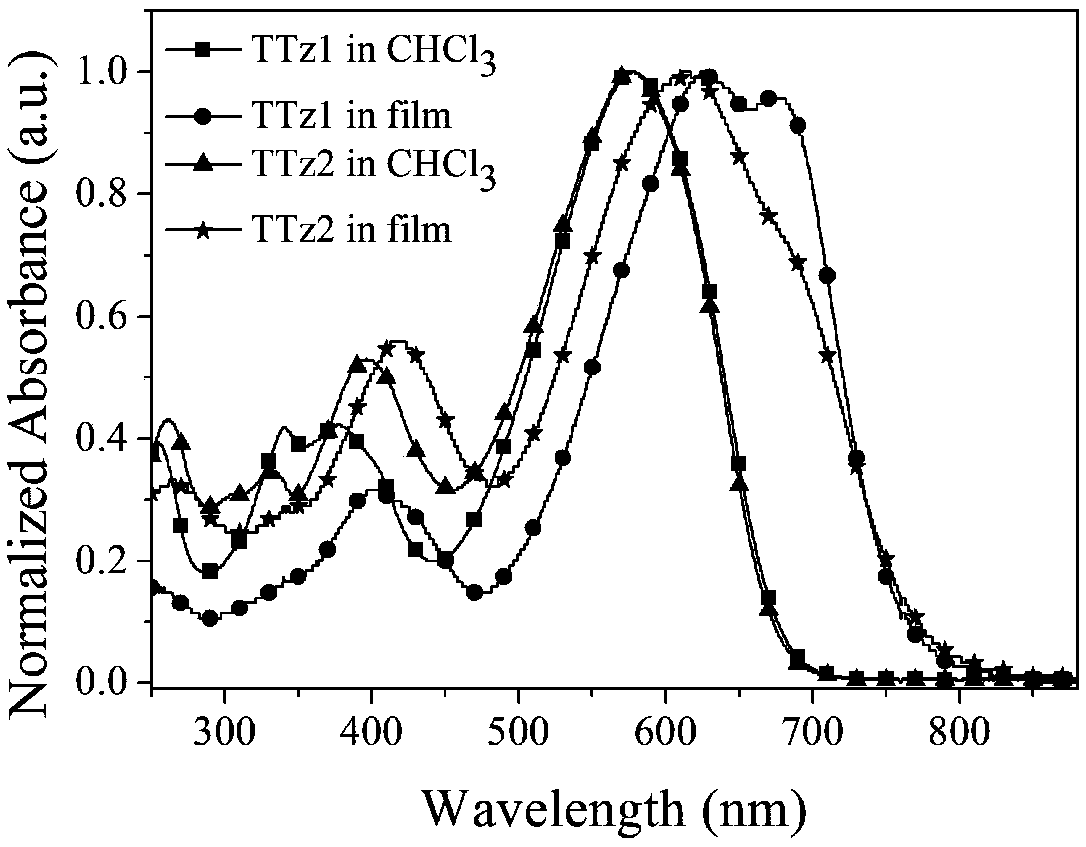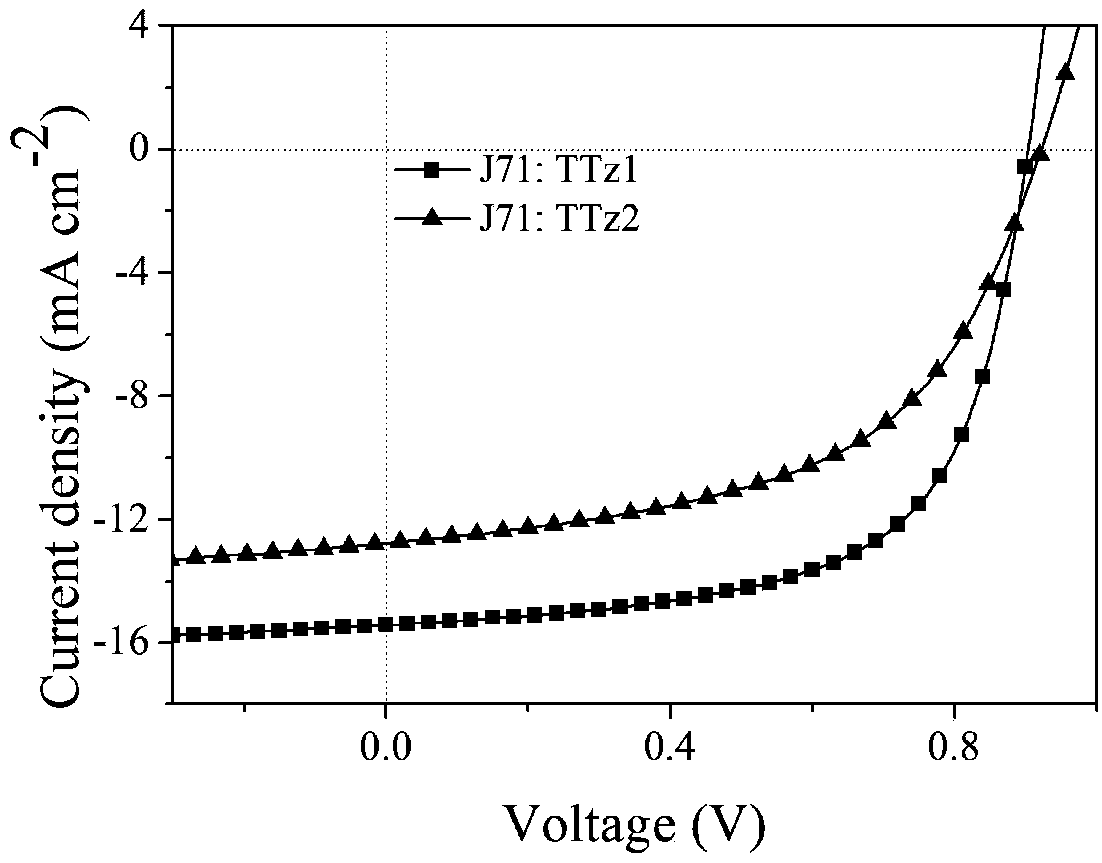Preparation and application of A2-pi-A1-pi-A2 type small molecule receptor materials taking thiazolothiazole as core
A technology of small molecule acceptors and thiazolo, which is applied in the field of organic photovoltaics, can solve the problems of high synthesis cost and difficult adjustment of film formation stability, and achieve fewer synthesis steps, optimized absorption and carrier mobility, and strong application potential Effect
- Summary
- Abstract
- Description
- Claims
- Application Information
AI Technical Summary
Problems solved by technology
Method used
Image
Examples
Embodiment 1
[0050] A with thiazolothiazole as the nucleus 2 -π-A 1 -π-A 2 Synthesis of small molecule receptor material TTz1.
[0051] The synthetic route of TTz1 is as follows:
[0052]
[0053] 1.1 Synthesis of 2-bromo-3-(2-butyloctyl)thiophene (2)
[0054] In a 250 mL three-necked flask, sequentially add compound 1 (10 g, 39.6 mmol), N-bromosuccinimide (8.46 g, 47.6 mmol), and 150 mL of glacial acetic acid. Under the protection of light, react at room temperature for 12 hours, stop the reaction, transfer the reaction solution to a separatory funnel, add 50mL distilled water, extract with dichloromethane, dry with anhydrous magnesium sulfate, remove the organic solvent by distillation under reduced pressure, and remove the residue with petroleum ether Column chromatography was used as the eluent to obtain compound 2 as a colorless oil (12.2 g, yield 93%). 1 H NMR (400MHz, CDCl 3 )δ7.18(d, J=5.6Hz, 1H), 6.76(d, J=5.6Hz, 1H), 2.49(d, J=7.2Hz, 2H), 1.65(dd, J=11.1, 5.9Hz, 1H), 1....
Embodiment 2
[0066] A with thiazolothiazole as the nucleus 2 -π-A 1 -π-A 2 Synthesis of small molecule receptor material TTz2.
[0067] The synthetic route of TTz2 is as follows:
[0068]
[0069] In a 100mL two-neck flask, sequentially add compound 7 (200mg, 0.21mmol), compound 8 (382mg, 2.07mmol), triethylamine (0.5mL) and chloroform (60mL), under the protection of nitrogen, reflux reaction at 65°C 24h. Cool to room temperature, pour into 200mL of anhydrous methanol for precipitation, filter with suction, and use chloroform as eluent to separate the crude product by column chromatography, and recrystallize from chloroform and acetone to obtain a maroon solid compound with metallic luster TTz2 (230 mg, 83% yield). 1 H NMR (400MHz, CDCl 3 )δ8.32(s,1H),7.95(s,1H),7.76(d,J=7.7Hz,1H),7.56(d,J=7.7Hz,1H),4.35-4.29(m,2H), 2.94-2.82 (m, 2H), 1.89 (t, J=16.9Hz, 1H), 1.51-1.26 (m, 19H), 0.97-0.87 (m, 6H).
Embodiment 3
[0071] Performance characterization of small molecule acceptor materials TTz1 and TTz2 and preparation and testing of photovoltaic devices:
[0072] of the synthesized compound 1 The H NMR spectrum was measured by Bruker Dex-300 NMR or 400NMR instrument, the UV-visible absorption spectrum was measured by Shimadzu UV-800 UV-visible spectrophotometer, and the cyclic voltammetry curve was tested by CHI630E electrochemical analyzer.
[0073] An organic solar cell device based on this type of small molecule acceptor material includes an indium tin oxide (ITO) conductive glass anode, a cathode modification layer, a photoactive layer, an anode modification layer, and a cathode. The active layer material is the small molecule acceptor material described in the present invention and a commercially purchased polymer donor material, and the blending weight ratio is 1:2.
[0074] 3.1 Determination of photophysical properties of small organic molecule receptors TTz1 and TTz2
[0075] fi...
PUM
| Property | Measurement | Unit |
|---|---|---|
| optical band gap | aaaaa | aaaaa |
| open-circuit voltage | aaaaa | aaaaa |
| energy conversion efficiency | aaaaa | aaaaa |
Abstract
Description
Claims
Application Information
 Login to View More
Login to View More - R&D
- Intellectual Property
- Life Sciences
- Materials
- Tech Scout
- Unparalleled Data Quality
- Higher Quality Content
- 60% Fewer Hallucinations
Browse by: Latest US Patents, China's latest patents, Technical Efficacy Thesaurus, Application Domain, Technology Topic, Popular Technical Reports.
© 2025 PatSnap. All rights reserved.Legal|Privacy policy|Modern Slavery Act Transparency Statement|Sitemap|About US| Contact US: help@patsnap.com



